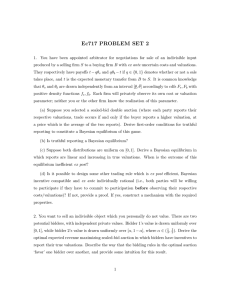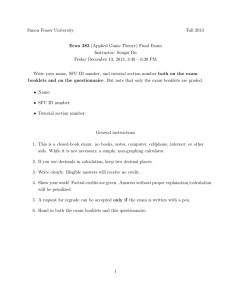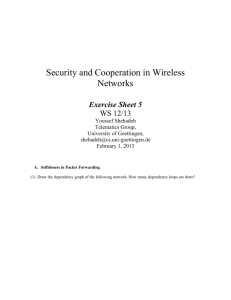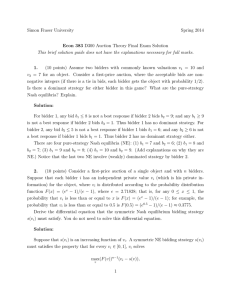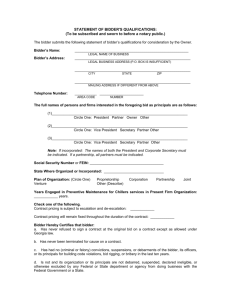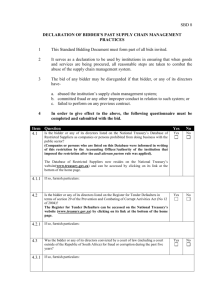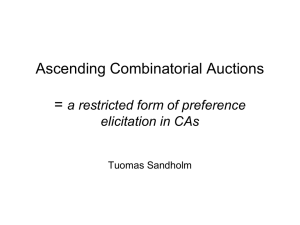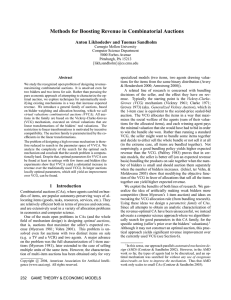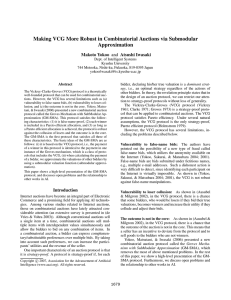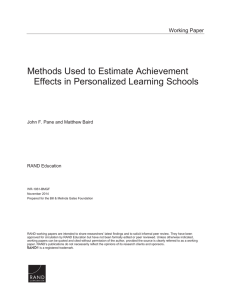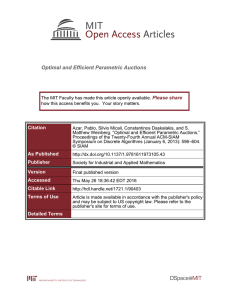Simon Fraser University Spring 2014 Econ 383 D300 Auction Theory Final Exam
advertisement
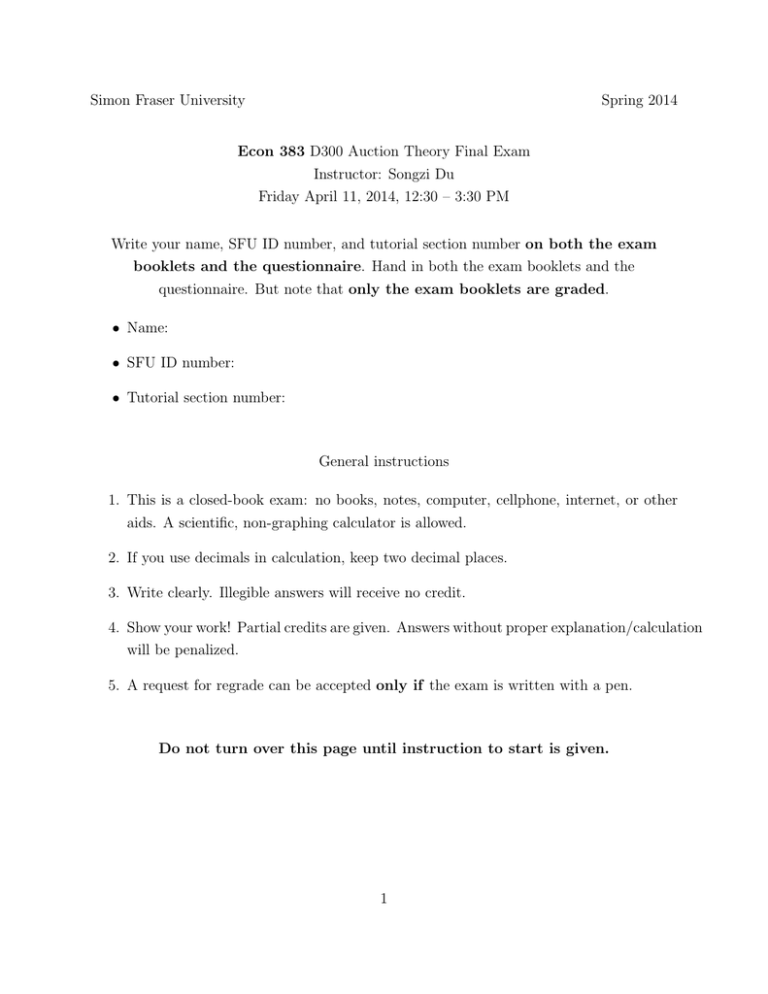
Simon Fraser University
Spring 2014
Econ 383 D300 Auction Theory Final Exam
Instructor: Songzi Du
Friday April 11, 2014, 12:30 – 3:30 PM
Write your name, SFU ID number, and tutorial section number on both the exam
booklets and the questionnaire. Hand in both the exam booklets and the
questionnaire. But note that only the exam booklets are graded.
• Name:
• SFU ID number:
• Tutorial section number:
General instructions
1. This is a closed-book exam: no books, notes, computer, cellphone, internet, or other
aids. A scientific, non-graphing calculator is allowed.
2. If you use decimals in calculation, keep two decimal places.
3. Write clearly. Illegible answers will receive no credit.
4. Show your work! Partial credits are given. Answers without proper explanation/calculation
will be penalized.
5. A request for regrade can be accepted only if the exam is written with a pen.
Do not turn over this page until instruction to start is given.
1
Write Question 1–3 on booklet #1.
1.
(10 points) Assume two bidders with commonly known valuations v1 = 10 and
v2 = 7 for an object. Consider a first-price auction, where the acceptable bids are nonnegative integers (if there is a tie in bids, each bidder gets the object with probability 1/2).
Is there a dominant strategy for either bidder in this game? What are the pure-strategy
Nash equilibria? Explain.
2.
(10 points) Consider a first-price auction of a single object and with n bidders.
Suppose that each bidder i has an independent private value vi (which is his private information) for the object, where vi is distributed according to the probability distribution
function F (x) = (ex − 1)/(e − 1), where e = 2.71828; that is, for any 0 ≤ x ≤ 1, the
probability that vi is less than or equal to x is F (x) = (ex − 1)/(e − 1); for example, the
probability that vi is less than or equal to 0.5 is F (0.5) = (e0.5 − 1)/(e − 1) ≈ 0.3775.
Derive the differential equation that the symmetric Nash equilibrium bidding strategy
s(vi ) must satisfy. You do not need to solve this differential equation.
3. (10 points) There are five buyers {x, y, z, w, u} and five objects {a, b, c, d, e}. The
valuations are given in Table 1. Assume that each buyer wants only one object. Find an
optimal matching, i.e., one that maximizes social welfare, and find a set of market-clearing
prices. Explain and/or show why your matching is optimal and why your prices are market
clearing.
Buyer
x
y
z
w
u
value for a value for b
3
3
4
1
3
2
5
2
3
3
value for c value for d value for e
2
1
1
1
1
0
0
0
0
2
1
2
2
1
2
Table 1
Write Question 4–6 on booklet #2.
4. (10 points) Suppose that there are two advertisers (B = {x, y}) and two advertisement slots (S = {1, 2}), and each advertiser wants only one slot. Here we consider general
2
valuation vi,j , where i ∈ S and j ∈ B, not necessarily multiplicative. The valuations vi,j ,
i ∈ S, are advertiser j’s private information.
(i) For what valuations is the matching (1–x, 2–y) social-welfare maximizing? For what
valuations is the matching (1–y, 2–x) social-welfare maximizing?
(ii) Describe the VCG mechanism for this setup. In your description you must consider
both cases in part (i).
(iii) What are the matching and payments given by the VCG mechanism when v1,x = 4,
v2,x = 3, v1,y = 5, and v2,y = 5 (and everyone reports truthfully)? Explain.
5. (10 points) Consider the VCG mechanism that sells two identical spectrum licenses.
(A spectrum license grants the licensee permission to transmit signals over a particular
portion of the radio frequency spectrum in a given geographical area.) In the following
scenarios suppose that all bidders play their dominant strategy of bidding truthfully in the
VCG mechanism.
(i) Bidder 1 and 2 are both new entrants in the wireless market, and each needs two
licenses to establish a business of economic scale. Bidder 1 is willing to pay up to $1
billion for the two licenses (and zero for any one license). Bidder 2 is willing to pay
up to $900 million for the two licenses (and zero for any one license). What are the
allocation and payments from the VCG mechanism with just bidder 1 and 2? Explain.
(ii) Bidder 3 and 4 are both incumbent wireless operators, and each seeks just a single
extra license to expand the capacity of its network. Suppose each incumbent is willing
to pay up to $1 billion for a single license (and zero for any additional license). What
are the allocation and payments from the VCG mechanism with bidder 1, 2, 3 and 4?
Explain.
(iii) Assume now that bidder 3 and 4 each is willing to pay only up to $400 million for a
single license (and zero for any additional license), and bidder 1 and 2 are as before.
What are the allocation and payments from the VCG mechanism with bidder 1, 2, 3
and 4? Explain.
6. (10 points) Suppose that there are three advertisers (B = {1, 2, 3}) and three advertisement slots (S = {1, 2, 3}), and each advertiser wants only one slot. Assume multiplicative
3
valuation vi,j = ri vj , where i ∈ S and j ∈ B, where ri is slot i’s clickthrough rate and vj is
buyer j’s revenue per click. And assume it is common knowledge that r1 = 5, r2 = 4, r3 = 3,
v1 = 7, v2 = 5 and v3 = 3. Consider the generalized second price (GSP) auction.
(i) Construct a Nash equilibrium of the GSP auction that is revenue-equivalent to the
VCG mechanism, and explain why no one has an incentive to deviate.
(ii) Is b1 = 10, b2 = 4 and b3 = 3 a Nash equilibrium of the GSP auction? Why or why
not?
4
